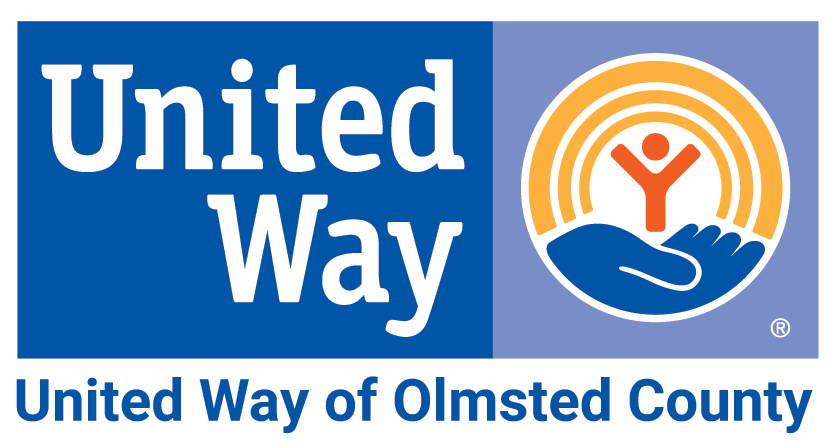
OUR MISSION
Uniting people and resources to improve people’s lives in our community.
OUR VISION
To be an agent of community change that inspires hope, creates opportunity, and champions people in need.
OUR VALUES
We Live United for universal success and prosperity in SE Minnesota.
To that end, we work with public, private, and nonprofit partners to improve lives and empower every family to succeed by uniting around education, health, and financial stability - the cornerstone of a strong, equitable community.
INTEGRITY
EQUITY
We value the intentional inclusion of everyone in our community. We strive to dismantle systemic, institutional, and historical barriers based on race, gender, sexual orientation, and other identities so they no longer determine socioeconomic, education and health outcomes.
EXCELLENCE
Our efforts exceed our customers’ expectations. We lead our peers in every performance measure.
ACCOUNTABILITY
We establish and demonstrate with every opportunity the highest standards of stewardship.
LEADERSHIP
We participate in solving problems facing our community by mobilizing resources for collective action. Our leadership gives direction to the community in the pursuit of optimizing our community’s well-being.
A BRIEF HISTORY
On October 29, 1925 a joint meeting of the Kiwanis and Rotary clubs along with the “business men of Rochester” was held in the Arthur Hotel. According to the minutes, the meeting was called “for the purpose of crystallizing sentiment in favor of a Community Chest for Rochester and to form [the] organization.” Mr. Gilbert Utz recommended a plan for organizing a Community Chest in Rochester. J. A. Melone’s motion to form a Community Chest carried and an executive board was unanimously elected.
The first “Financial drive” raised $26,740.00 and was led by Henry Brock. And so it would go, better years, worse years, depression years, prohibition years, war years. Decades of committee meetings, fund-raising, committee meetings, receiving requests for funds, committee meetings, distributing those funds, and committee meetings. Volunteers, a few paid staff, time, effort, and the steady generosity of a community all working together to support people in need.
In the Annual Report of January 29, 1963, Robert C. Roesler observed that while the past year had been the 38th year of operation for the Community Chest, it was “also the first of an anticipated series of successful years for the United Fund of Greater Rochester.” Roesler expressed his belief that the “same citizen dedication and diligence which has meant success for the Chest will assure the future of the United Fund.” Ten months before the Community Chest Board had voted unanimously to organize a United Fund.
The United Fund’s first campaign, chaired by Harold E. Kamm, raised $268,307.00. By its final campaign in 1971, led by M. S. LaPree, the United Fund was raising over twice that amount - $577,504.00.
In 1972, the United Fund of Greater Rochester became the United Way of Olmsted County. This change not only brought a “new look to our organization,” wrote President Clifford M. Johnson in the Annual Report of 1972, “but also involved an expansion of services to more people.” The year saw 1,400 new first-time donors and “growing partnerships with public service agencies and governmental units.” This first United Way campaign, chaired by O. D. Robinson, raised $635,456.00.
On February 14, 1976, United Way published in the Post-Bulletin a questionnaire to review “current and future needs” asking readers to select from a list of a dozen problems the three they found “most pressing.” In March 2002, the United Way released its first preliminary Community Needs Assessment Report on a wide range of community needs. In the foreword co-chairs of the Community Impact Task Force, Phil Wheeler and Jim Rustad described the report as “an important part of the commitment that the Olmsted County United Way has made to focus its efforts and resources on the most important needs in our community and on programs which have the highest impact on those needs.”
In 2003, a merger with CommunityNet was accomplished bringing to United Way of Olmsted County the Volunteer Center and 2-1-1 information and referral. Following the 2003 needs assessment, the organization began a transformation of its mission that shifted it from a “fund-raising/pay-through” model to one that aligned with a “community impact” model.
With our Centennial anniversary forthcoming, the work of thousands of people and tens of thousands of hours has always been about more than raising money. “How much” was an easy way to keep score, but it was “what for” that mattered.
EQUITY STATEMENT OF PRINCIPLE
Racism and discrimination have no place in our world, and we stand in solidarity with all those who seek equity and justice. We envision a community where everyone can participate, prosper, and reach their full potential. A community where race does not predict health or wealth, life or death.
The United Way of Olmsted County Board of Directors recognizes equity as a core value that is critical in achieving United Way’s mission. We value the intentional inclusion of everyone in our community.
We strive to dismantle systemic, institutional, and historical barriers based on race, ethnicity, ability, and other identities so they no longer determine socioeconomic, education, and health outcomes.
Our mission compels us to prioritize people in our community who have been marginalized and excluded. United Way of Olmsted County is committed to finding and implementing community-driven solutions that ensure all people have the resources and opportunities needed to reach their full potential. We commit to leveraging all our strategies, investments, and partnerships to building a more equitable community.
